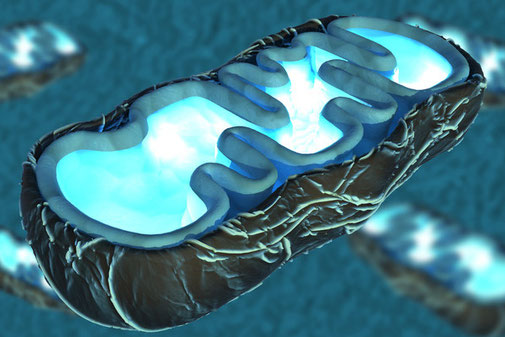Tennee | September 10, 2016

If you are a parent you probably know well or remember, keeping up with the boundless energy of a young child. From the first light of day until bedtime little children have the ability to effortlessly run circles around grownups. Similar to little energizer batteries...”they keep going and going and going”. The truth is that the energy levels of human beings are directly representative of the energy inside their cells. For within the cells structure are little “energizer batteries” called mitochondria, designed perfectly to support energy production. However, as our bodies age, our mitochondrial function goes down and our energy levels decrease as a result.
With that in mind, what would your life look like if you could increase and fine tune your cellular “powerhouse” energy so that you could live a more youthful energetic existence? Would you need coffee in the morning or afternoon or stimulants throughout the day? Would you start exercising again or spend more time doing the things that bring you joy?
The interest in mitochondrial health has been building and over the last decade, professional athletes have been fine tuning the mechanisms of mitochondrial function in order to achieve athletic excellence. Researchers in medicine have also prioritized mitochondrial research and have published thousands of studies linking abnormal mitochondrial dysfunction to neurodegenerative diseases like Alzheimer’s, Parkinson’s, diabetes, obesity, autoimmune conditions, cancer, heart disease, stroke and aging. In fact, studies show that over 50 million people in the U.S. are said to be affected by mitochondrial dysfunction. More recently, mitochondria health has become more mainstream due to the multitude of prominent biohackers, physicians and researchers such as Dr. Terry Wahls, Dave Asprey, Nick Lane, Dr. Jack Kruse, etc, that have written books and created protocols for rebuilding and boosting mitochondrial function. For those interested in building or maintaining a robust healthy body, there is irrefutable evidence that mitochondrial health plays a key role.
What are your mitochondria and why are they so important?
Your mitochondria are tiny powerhouse units in the cell that are present in almost every complex-celled organism on the planet, including plants and animals. Mitochondria are part of the subunit of a cell and act by converting the energy stored in the foods we eat into ATP, for our bodies to use as fuel. While mitochondria have several important functions, the most well known and prominent function is that of energy production. You house over a quadrillion mitochondria distributed all throughout your body. These units of energy are extremely important for your vitality as they produce 90% of the energy that fuels the body. This means, if your mitochondria are not operating well, then your energy, metabolism, cognitive and immune function will suffer as a result. Its interesting to note that in scientific journals, research has found that cancer cells have radically lower levels of mitochondria within the cell.
I like the analogy that compares the mitochondria to the workings of the digestive system. Essentially, the mitochondria take in nutrients and break them down to produce a molecular “currency” or ATP. This ATP is the fuel for the the body, meaning it is responsible for powering all biological functions. This process takes place in the mitochondrial membrane, where the molecules also serve as conductors for ATP throwing off electrons, resulting in free radical exposure. This process also renders the mitochondria vulnerable to oxidative damage. Ultimately, as you age and or expose yourself to factors that increase the levels of oxidative damage in your cells, (i.e. toxins, environmental stressors, infections) your mitochondria become weathered and eventually dysfunctional. Fortunately, researches and scientists are finding a multitude of ways to feed, restore and recharge your internal cellular batteries.
/Source: NCBI
Factors that affect your mitochondrial health
- Genetics - Mitochondrial diseases are the result of either inherited or spontaneous mutations in mtDNA or nDNA which lead to altered functions of the proteins in RNA molecules that normally reside in mitochondria.
- Aging - A decline in mitochondrial function plays a huge role in the aging process. This is reflected in declines in mitochondrial energy metabolism, enhanced mitochondrial oxidative stress and an accumulation of mtDNA mutations. /Source: NCBI
- Diet - As everything begins in the gut, your diet can make or break your mitochondrial health. Dr Bruce H Cohen M.D., a neurologist and expert on mitochondrial diseases states that as a society we are “overfeeding and undernourishing our mitochondria” which points a finger directly at the epidemics of obesity and type II diabetes.
- Lifestyle - As with diet, your lifestyle choices will either support your mitochondrial health or dysfunction. Sedimentary lifestyles undermine good health.
- Environment - Scientists now attach growing importance to environmental factors that trigger mitochondrial problems. Chemical exposures, alcohol, cigarette and other toxicants can tip the scales that can lead to metabolic illness. /Source: NCBI
4 Keys to Building Mitochondrial Health through Biogenesis
1. Exercise
Exercising on a regular basis stimulates the mitochondria to multiply, generating more energy. It also stimulated mitochondrial biogenesis in the brain which gives us more brainpower! Exercising essentially forces the mitochondria to work harder and the result is that it expands the network of mitochondria within a cell. It has also been found that exercise induces changes in mitochondrial enzyme content and activity, which in turn increases your cellular energy production and decreases the risk of chronic disease.
/Source: NCBI
2. Intermittent fasting
Intermittent fasting is a eating pattern where you cycle between periods of eating and fasting within specific windows of time that allow your mitochondria to rid itself of waste. The process of fasting gives your body the signal to switch from using its normal mechanism to use glucose for energy to using a fatty acid. This can cause the cells to turn on survival processes to remove unhealthy mitochondria and replace them with healthy ones. Over timer this reduces the production of free radicals. This mechanism is called mitophagy. In this state the body is fasting and able to disassemble damaged parts, allowing the body to essentially clean house. Colin Champ M.D. an oncologist at the University of Pittsburgh Medical Center states “Mitophagy happens at the cellular level where the membranes break down and your body recycles what’s healthy and uses the rest for energy, or to make new parts. This process may also play a role in controlling the amount of inflammation in the body.” The loss of mitochondrial autophagy has been linked to an increased risk of Cancer, Parkinsons diease, Huntington’s disease, Alzheimers disease and decreased immunity. Intermittent fasting has been shown to be especially beneficial in relation to mitochondrial function when you refrain from eating 3 hours before bedtime. This is due to the fact that mitochondria are responsible for burning the fuel in the body and excessive fuel will generate excessive free radical damage. So in essence, fasting before bed gives your body the chance to get an edge on its repairs.
/Source: NCBI
3. Ketogenic Diet
A ketogenic diet is rich in fat and low in carbohydrates. Ketogenic diets are becoming more and more popular with everyone from athletes to those healing from chronic illness. The purpose of utilizing a ketogenic diet is to change the metabolic state by which the body uses a specific food source for fuel and energy to strengthen the mitochondria. When mitochondria are fueled by ketones instead of glucose, their ability to produce ATP is enhanced and free radical by products are reduced.
Ketosis results in adaptive changes in energy metabolism including a striking enhancement in mitochondrial biogenesis that leads to an increase in energy stores. The mechanics of this are explained by looking at how carbohydrates use the electron transport chain. Within healthy mitochondria, fats are broken down using a process called the TCA cycle. The TCA cycle can be used to circumvent defective mitochondria.
Ketogenic diets can be especially protective against many diseases that affect the brain and nervous system and are used with people suffering from epilepsy, Alzheimer's, mitochondrial myopathy, autism, diabetes, and cancer just to name a few. Dr Terry Wahls explores ketosis in her book The Wahls protocol, a remarkable book exploring the journey Terry Wahls underwent to put the brakes on her Multiple Sclerosis and restore the function of her body.
/Source: NCBI
4. Nutrients that boost mitochondrial function
There are a slew of nutrients that are essential for mitochondrial health, here are a few crucial ones.
Glutathione | Glutathione is a powerhouse molecule that our bodies produce made up of cysteine, glutamate and glycine amino acids. Mitochondria depend heavily on glutathione for their well being. Glutathione has many functions in relation to mitochondrial health. Glutathione is an intracellular antioxidant that requires ATP for synthesis. The mitochondria use glutathione to clean up and neutralize the free radicals produced during the creation of ATP. Glutathione is also a key “garbage cleanup” mechanism and uses a sulfur compound in its cysteine amino acid makeup to clean up heavy metals.

Glutathione is also recycled by the body and reproduced when it is needed. External and internal stressors rely on glutathione to help with cleanup and this requires mitochondria for fuel. Essentially, glutathione and mitochondria are a team. When free radical damage isn’t mopped up, the mitochondria take the beating and the aging process is sped up.
Active glutathione is responsible for the the vitality of the mitochondria. Foods rich in glutathione include whey protein, cruciferous vegetables and milk thistle.
/Source: NCBI
B vitamins | B vitamins specifically: Folic acid, B1, B2, B3, B6,B7, B12, are mitochondrial boosting nutrients and are critical cofactors that participate in important mitochondrial reactions. Research has found that mitochondrial function is compromised with B vitamin deficiencies and B vitamins prevent mitochondrial toxicity. B vitamins are also critical in supporting the bodies methylation process which protects the mitochondria.
/Source: ScienceDirect
Alpha - Lipoic Acid | Alpha lipoic acid or ALA is both a coenzyme and an antioxidant. It also works like a synergist with B vitamins. It is known as a universal antioxidant because it is both water and fat soluble and is crucial for maintaining and repairing the nervous system. ALA is also a vital cofactor needed for enzymatic reactions within the mitochondria. ALA is one of the more well known has been extensively studied for its effects on preventing mitochondrial aging and boosting energy levels.* It is also well known for its ability to restore and maintain glutathione levels.

Some nutrition experts recommend supplementing alpha-lipoic acid and acetyl-l-carnitine to reduce oxidative stress and restore energy levels lost to mitochondrial decline. Best food sources of ALA include organ meats, broccoli and spinach.
/Source: NCBI
*Maczurek A, Hager K, Kenklies M, et al. Lipoic acid as an anti-inflammatory and neuroprotective treatment for Alzheimer’s disease.
Adv Drug Deliv Rev. 2008 Oct-Nov; 60(13-14):1463-70.
CoQ10 | The ubiquinol form of CoQ10 is a powerful antioxidant to add into the diet if you are working to overcoming mitochondrial dysfunction. This antioxidant increases mitochondrial respiration and acts as a free radical scavenger, dramatically reducing oxidative damage. CoQ10 is a known as a “antioxidant big brother” that protects tissue from DNA damage while facilitating the electron transfer and generating ATP. CoQ10 is naturally found in high levels of organ meats such as liver, beef, sardines, broccoli, spinach and cauliflower.
/Source: NCBI
Magnesium | Magnesium is the 4th most abundant mineral in the body and serves as a critical co-factor in repairing damage to mitochondrial DNA as well as genomic DNA. As it turns out magnesium works brilliantly in tandem with exercise. Sufficient amounts of magnesium are needed to enhance ATP and you need magnesium as a cofactor to repair damage. Research has proven that magnesium inadequacy interferes with cellular metabolism. Good sources of magnesium include dark chocolate, dark leafy greens, nuts, fish and avocados. /Source: NCBI

Omega 3s | Omega 3 fatty acids (DHA/EPA) are necessary for heathy cell structure and function. Specifically, docosahexaenoic acid (DHA) is an omega3 fatty acid that makes up more than 90 percent of the omega 3 fats in the brain. The mitochondria use DHA as a source of fuel to produce ATP.
Simple sugars such as glucose are traditionally used by the mitochondria but DHA can also be used as an alternative fuel source. Due to the amount of carbon atoms that the DHA has, (22) it can be used as an excellent source of stored energy which can be used by the brain and heart for their great energy uses. Seafood such as sardines and krill are some of the best sources of omega 3’s.
L-Carnitine | This critical molecule creates ATP via oxidative phosphorylation and provides mitochondria with both the energy needed as well as antioxidant protection that they must have to retain a youthful function. It also is effective in reducing fatigue, enhancing cardiovascular function, and delaying or reversing brain degeneration. Red meats, dairy, bee pollen and collard greens are good sources for carnitine.
/Source: NCBI
D-Ribose | D-Ribose is a 5 carbon sugar that provides a key building block of ATP.
D-Ribose stimulates the metabolic pathway to produce ATP. This makes D ribose critical to energy recovery.
Red meat, poultry, fish and nuts, mushrooms are some of the many sources of Ribose.

N-Acetyl Cysteine | This is a potent mitochondrial enhancer that is well known for its antioxidant action and is essential for the formation of glutathione inside cells.
NAC also supports nerve and liver function. It also can help to inhibit cytokine cascades which are inflammatory messengers stimulated by microbes. NAC converts to cysteine in the body. Sources of cysteine include turkey, duck, sausage, garlic and broccoli.
/Source: NCBI
At the end of the day we are only as healthy and happy as our cells.
May you feed and nurture your body in ways that nourish your existence.
Thanks for reading my blog.
If you like this please share!

Write a comment
Anne and Al Arredondo (Sunday, 18 September 2016 16:54)
Hi, Tennee! Janno emailled us this article - I shall read every word- but at the moment I just want to send you a big "hello" and lots of love ... it makes me happy to know that you and Janno keep in touch. Say hi to your mom for us.
Anne and Al
<alanne.arredondo@gmail.com>
Tennee (Thursday, 15 December 2016 10:10)
Hi Al and Anne! Thanks so much for your kind words! Be well!